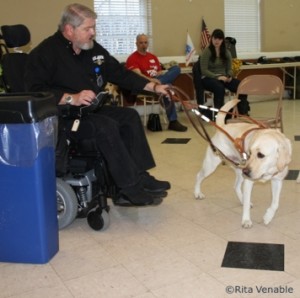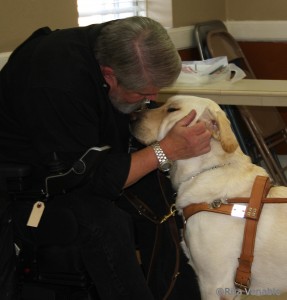Beside the five senses there is a sixth sense, of equal importance—the sense of duty.
—Christian Nestell Bovee, Intuitions and Summaries of Thought
Ron, a former guide dog, and Terry Staggs, a former Green Beret, are cut from the same cloth. Both have led unconventional lives of service to others and both are retired because of injuries obtained in the line of duty. Also, despite many obstacles, both have been repurposed to useful lives post-retirement.
Ron is an 80 lb., reddish-yellow Labrador retriever with a Rock of Gibraltar demeanor and the knowing eyes of a dog intuitively aware of his surroundings. He was specially bred for guide dog work by Southeastern Guide Dogs (SEGD) headquartered in Palmetto, Florida. At a young age, he underwent extensive training to perform as a guide dog for blind people in wheelchairs. Ron had to learn to keep his paws from underneath the wheels, find street curbs, and navigate obstacles. Also, he learned “intelligent disobedience,” to keep a person from tumbling down a flight of stairs, for example, or whacking into a tree limb that they cannot see.
After Ron’s training was complete, he was matched with Terry, his first owner. Terry is a self-described “big, bad, Special Forces First Sergeant” who knew from an early age that he wanted to be a soldier. He was a Green Beret, spending time in Viet Nam, Korea, Grenada, and Kuwait. He was in the army for 19 years, 6 mos., and 23 days and only had 6 months until retirement when Desert Shield and Desert Storm called him to go overseas again. While clearing a building in Kuwait, he was hit by a grenade that blew him into a wall. He was left blind in one eye and his army career was over. His other eye eventually succumbed to glaucoma. Terry went through several guide dogs, each retiring when they reached about seven years old.
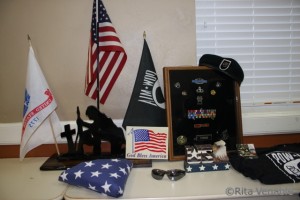
Later, Terry had a stroke due to a piece of shrapnel (from the Kuwait grenade) in his leg that moved to his brain. “It put me in a wheelchair,” Terry said. He then got Murphy, the first dog trained to lead a blind person in a wheelchair. After Murphy retired, Ron was his replacement.
“Now, Ron, whatever you wanted him to do, he was willing to please you and he did it,” said Terry. “Having these dogs has really made me independent. I don’t sit at home any more.”
Ron and Terry became close companions, but it was an event that occurred on August 9, 2009, that was a defining moment in both of their lives. Terry relates, “I live on a very busy highway, Hwy 31 down in Giles County in a little place called Lynnville (Tennessee). Every day I would have to cross this street to get my mail. About 1:00 in the afternoon, I was crossing the street to go to the mailbox, and Ron jerked me completely out of the chair and into a ditch. A young man, 18 years old, was on crack and driving down the road toward us. Ron saved my life because the boy that was driving the car never even knew he hit my wheelchair.”
Fortunately, neither Ron nor Terry was injured. Later, however, a van they were riding in was rear-ended on Nolensville Road in Nashville. Terry was unhurt, but Ron was thrown out of the back seat into Terry’s wheelchair, and was then slammed against a door. He sustained an injury to his hindquarters that ended Ron’s career as a guide dog.

Terry needed an able dog, but he could not keep two dogs. He had parted with other guide dogs and it was never easy. “I’ll tell you, not too much gets to me, but whenever I have to let a dog go, I go to my room, and me and myself, we cry until we’re satisfied that we’re okay. It hurts, but you know they are going to another good home and that’s what counts.”
But how do you part with the dog that has saved your life?
“I got lucky this time,” Terry explains, “I called Ms. Becky (Area Coordinator for SEGD puppy-raisers in Nashville) and I asked her if she knew anybody who would want to take Ron, and she said, ‘When can I come and pick him up?’” Becky adopted Ron and he now lives with her and her other dogs— a Newfoundland and a golden retriever—just a couple of counties away from Terry. Recently, Ron and Terry had a reunion when Terry was speaking at a youth program in Nashville that Becky and Ron attended.
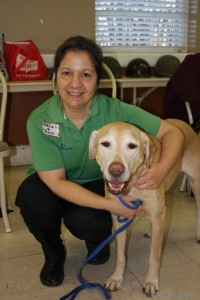
Losing his eyesight and his ability to walk has not stopped Terry from being active in his community. Since retiring from the Army, Terry went back to college and got a bachelor’s degree in social work followed by a master’s degree in youth ministry. He is now assistant pastor and youth minister at his church in Lynnville. “I don’t just go to church on Sunday and work with my youth group there; I’m out in my community doing things,” Terry explains to the young men at the youth program. “You’ve got life experiences that you can put out there, too. You can do anything you want to do.”
And Ron’s post-retirement career? He’s helping to show the ropes to at least one young pup being raised in the Nashville area for SEGD. Our dog, Argo, was apprehensive about riding elevators. The SEGD puppy manual suggests that young pups ride with an older, more experienced dog to act as a mentor. Becky brought Ron and met my husband, Argo, and me at a nearby location. We rode elevators for an hour. Ron rode up and down like a champ like he did this all day, every day. Argo took his cues from Ron, at first sniffing under his face for signs of alarm. Ron stood like a general, signaling to Argo that elevators are easily managed. It’s all in the line of duty.
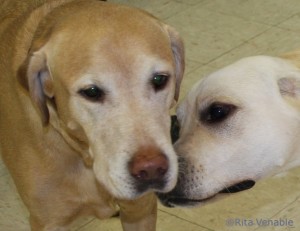
Note: This is the 85th anniversary of the first guide dog program in the United States, The Seeing Eye, which was first established in Nashville, Tennessee by Morris Frank. January is also National Mentoring Month.
Epilogue: Terry’s New Dog, Gilbert
